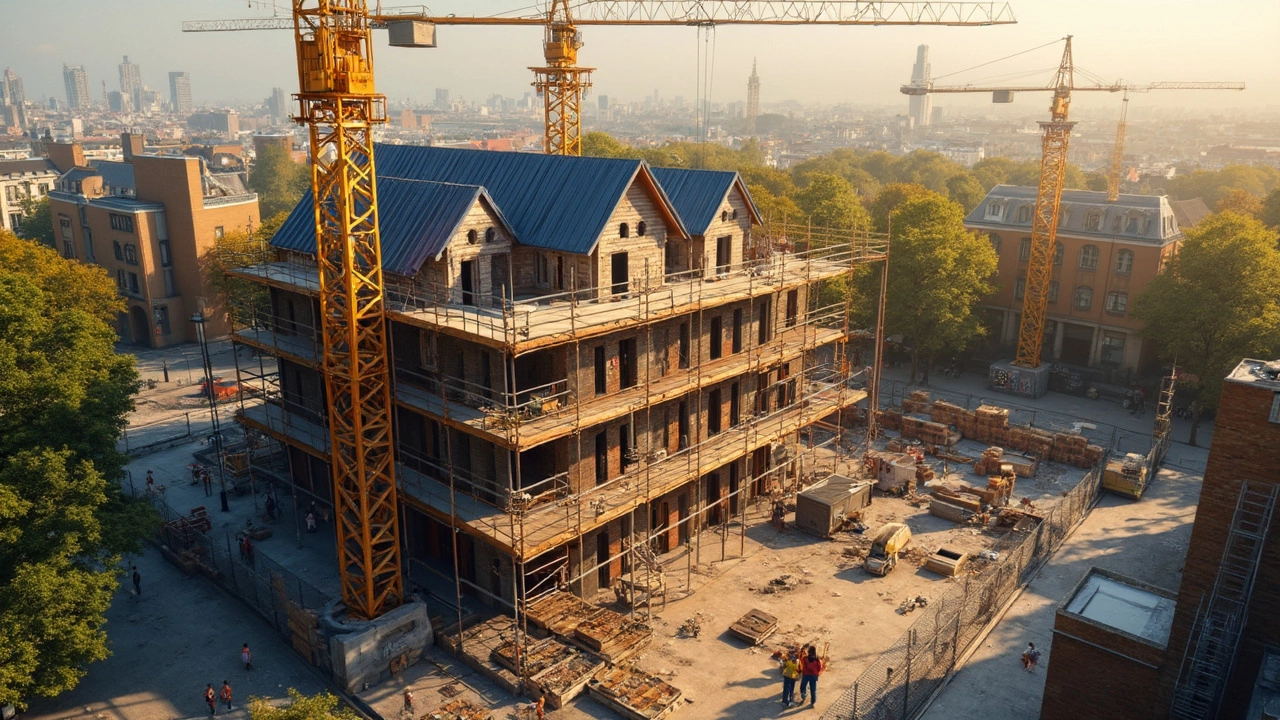If you've ever dreamed of building your own house, you've probably already asked the big question: why is it so darn expensive? I mean, we're talking numbers that could make your wallet cry. But there's more to these costs than just bricks and sticks. So, what's really jacking up the price?
The first culprit is usually the cost of materials. Over recent years, we've seen prices for lumber, steel, and even concrete take a wild roller-coaster ride. Global disruptions, trade policies, and good old supply and demand play a part here. And it's not just about the raw stuff; even things like kitchen cabinets or flooring can come with sticker shock.
Then there's labor. Skilled workers aren't just strolling around ready to swoop in at bargain rates. They know their value! The expertise of electricians, plumbers, and all those tradespeople doesn’t come cheap, and rightly so. Quality craftsmanship ensures your dream house doesn't turn into a DIY catastrophe.
- The Rising Cost of Materials
- Labor: More Than Just a Hard Hat
- Land: The Solid Ground of Expenses
- Permits and Red Tape
- Unexpected Costs and Contingencies
- Tips to Lower Building Costs
The Rising Cost of Materials
So, why are building costs skyrocketing when it comes to materials? Well, it's a mix of global chaos and good old supply and demand. In the past few years, the price of lumber alone has given folks a major headache. Remember back in 2021 when prices shot up by nearly 300% at one point? Yep, that wasn't fun for anyone building a home.
The pandemic threw a wrench in the global supply chain, slowing production and shipping. Plus, as more people decided they wanted to build or renovate (cue all those pandemic-induced DIY projects), demand just kept going up.
Larry Swimmer, a well-regarded economist, stated in a recent interview, "Material prices are often the silent killer in any construction budget. With every interruption in supply, there's a ripple effect that eventually hits consumers hard."
And it's not just lumber. Steel prices have also been on a roller coaster, thanks to international tariffs and trade issues. Not to mention concrete, which has seen a steady rise due to energy costs.
| Material | 2020 Average Cost (per unit) | 2025 Average Cost (per unit) |
|---|---|---|
| Lumber | $400 | $1,200 |
| Steel | $600 | $850 |
| Concrete | $100 | $140 |
Seeing those numbers, it's easy to understand why everyone in the home building world seems to be gripping their wallets a bit tighter. So, when planning out your new build, keep in mind these shifts in the market. Nobody wants unexpected surprises that bust the budget. Stay informed and always leave room for a little wiggle, financially speaking.
Labor: More Than Just a Hard Hat
When you're looking at building costs, labor can feel like the silent heavyweight in the equation. The workforce involved in constructing your dream home isn't just popping in for a day’s work. Skilled tradespeople like plumbers, electricians, and carpenters bring expertise that’s essential for the quality and safety of your home.
It's crucial to understand why labor costs can shoot up. First, there's a huge demand for skilled workers, and the supply isn't keeping pace. This mismatch means that hiring a qualified electrician or a seasoned plumber requires some serious negotiating. And guess what—those negotiations often end up reflected in the total cost.
Ever thought about certifications and licenses? Yeah, those aren't freebies. Pros don’t just wake up one morning and magically know how to do their jobs. They go through rigorous training, get certified, and keep up with the latest building codes and safety standards. And all that knowledge? Well, it doesn't come cheap, but it’s necessary to keep your home above par.
In many areas, labor costs might even surpass the price of some materials used. That’s especially true in regions where there’s a construction boom. With everyone rushing to build their cozy nests, contractors can demand higher wages and additional incentives to get on board a project.
Here's a little tip: if you want to keep labor costs down, consider planning your build during the off-peak season when things are a bit quieter. Also, get multiple quotes. It might take more time than just signing on the first dotted line you see, but it could save you a tidy sum in the long run.
Land: The Solid Ground of Expenses
When it comes to new home expenses, the land itself is a big chunk of the bill. Land costs can vary wildly depending on where you want to put down roots. City plots can be sky-high, while rural areas might offer more affordable options. But hey, you're not just paying for dirt because location is everything!
Consider zoning laws and local regulations—it might sound boring but diving into these will save you headaches down the line. Some areas have strict building codes, which might mean extra expenses to meet the required standards. It’s like having a 'no pets' rule but for how you can structure your home.
And don’t forget about amenities and infrastructure. Does the plot have access to utilities like water, electricity, and sewage? Installing these can rack up more building costs. Plus, if your dream plot is off the beaten path, you might need to think about road access.
Then there’s the quirky stuff. Have you ever heard of a soil test for contaminants and stability? This is especially crucial in areas prone to floods or earthquakes. It’s not just about picking the prettiest spot; it’s about making sure your house will stay put.
But here's a cool tidbit: if you create a detailed cost analysis before laying the first brick, you might catch potential land-related costs that are easily overlooked. Like those surprise survey fees or hidden environmental reports that can sneak up on you.
In summary, buying land isn't just a small piece of the puzzle; it's a whole chapter of your home building budget, full of hidden costs and critical decisions.

Permits and Red Tape
Oh, the joys of bureaucracy! If you've ever felt like drowning in a sea of paperwork, then building a house offers the deep dive experience of a lifetime. Getting the right permits is one of those pesky but non-negotiable steps you need to take if you want to avoid hefty fines—or worse, having to tear down what you’ve built.
The costs tied up here aren't just about cash; we're talking time too. The application process can be notoriously slow, taking up months before you even break ground. And when you're waiting for permits, a lot can change—like the price of that high-end fridge you were eyeing.
What sort of permits do you need? Here’s a not-so-fun fact: it varies. It depends on your area, the type of house you're building, and any special requirements. Generally speaking, you'll likely need:
- Building permit: Your golden ticket to start construction.
- Electrical permit: For wiring and power setups.
- Plumbing permit: Water and sewage systems have their own set of rules.
- Zoning permit: Ensures your home fits the area's regulations.
Then there are inspections. Yup, they're part and parcel of the process. Think of it as quality control—making sure your home is safe, up to code, and all spiffy.
And just when you think you’ve signed every form known to mankind, there might be more. Like environmental permits if you’re building near water. Or historic permits if your dream house happens to be in a heritage area.
It's wise to set aside a chunk of your home building budget for these expenses—around 5% to 10% of total costs, experts suggest. And keep regular tabs with your contractor; they often have an inside scoop on navigating these requirements efficiently.
Unexpected Costs and Contingencies
Alright, let's talk about those pesky unexpected costs that always seem to pop up when you're building a house. No matter how detailed your plan is, it's almost like unexpected expenses have a knack for sneaking into your budget.
First up, soil surprises. Yeah, that patch of dirt your house is supposed to sit on might hide some issues. Sometimes the soil isn't as stable as you thought, and you might need to invest in more stable foundations or extra drainage, which can quickly get pricey.
Next, there's always the chance of design changes. You might wake up one day and decide you need an extra bathroom or suddenly realize the open floor plan isn't cutting it. Modifications like these aren't just switch-flips; they can lead to additional charges for materials and labor.
Weather is another biggie. Think rain delays, or even worse, unforeseen disasters like storms or high winds, messing up the schedule. And as time stretches out, so do your costs.
Then you have permits and legal fees. You might find yourself tangled in extra red tape or suddenly needing more permits than initially expected. These aren’t free and can hit your budget out of nowhere.
Finally, don't forget about inflation. While it's not the fiery dragon in every project, it can still impact the prices of materials and construction pricing, even making a slight difference feel huge over the span of a long build.
So what can you do? Make sure to have a contingency budget in place—typically about 10-15% of your total budget. This little cushion can take a lot of stress out of these unforeseen events and keep your financial sanity intact. It's also a smart play to keep a close eye on your expenses as the project moves along. Being proactive rather than reactive can make all the difference in preventing budget disasters.
Tips to Lower Building Costs
Alright, so you're ready to tackle home building and keep that budget from exploding. It might feel like an uphill battle, but some sneaky strategies can help keep those building costs in check. Here's how:
First off, consider downsizing your plan. Smaller homes cost less to build! Focus on maximizing the space you have with an open floor plan. Additionally, rethink those fancy features. Sure, a home gym and gourmet kitchen sound nice, but are they essential?
Hunting for deals isn't just for Black Friday. Be smart about buying materials. Look for sales or consider using recycled materials where possible. Salvaged wood or reused bricks can add charm and save money.
Next, get several quotes for your major expenses, especially when it comes to construction pricing for electricians or plumbers. Don't just go with the first contractor you find. Comparing can unveil huge price differences!
- Plan Smart: Changing your plans mid-construction is like ordering a new dish at dinner after the chef's already started cooking. It's going to cost you. Make sure your plans are set before the foundation is poured.
- Tackle DIY Projects: Now, don't go overboard. But if you have the skills—or can learn from YouTube or a handy friend—some tasks, like painting or landscaping, can be a fun weekend project that also saves money.
- Effective Project Management: Keep tabs on everything. Delays and surprises are inevitable, but staying organized can prevent them from wreaking havoc on your wallet.
Remember, building a house is like running a marathon, not a sprint. Being patient and proactive will pay off when you see that final invoice. Keep these tips in mind, and hopefully, your new home won't just be beautiful—it'll be a budget-friendly beauty!
